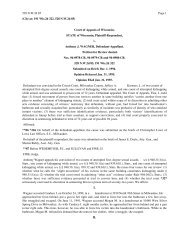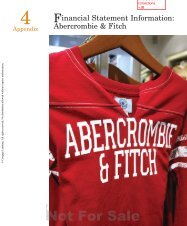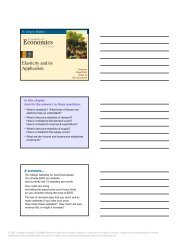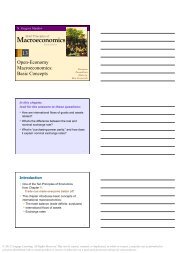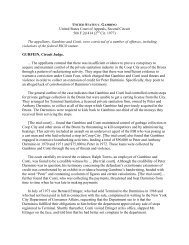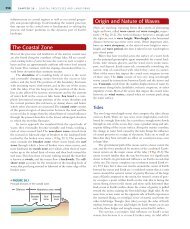On the Imperfections of Modern Music - Cengage Learning
On the Imperfections of Modern Music - Cengage Learning
On the Imperfections of Modern Music - Cengage Learning
Create successful ePaper yourself
Turn your PDF publications into a flip-book with our unique Google optimized e-Paper software.
IN THEIR OWN WORDS<br />
Giovanni Maria Artusi, <strong>On</strong> <strong>the</strong> <strong>Imperfections</strong> <strong>of</strong> <strong>Modern</strong><br />
<strong>Music</strong> (1600), and Claudio and Giulio Cesare Monteverdi,<br />
Scherzi musicali (1607)<br />
The Artusi-Monteverdi controversy—like <strong>the</strong> Wagner-Brahms contretemps about<br />
<strong>the</strong> “music <strong>of</strong> <strong>the</strong> future” (see In Their Own Words for Chapter 55)—was one <strong>of</strong><br />
several important debates in <strong>the</strong> history <strong>of</strong> music in which <strong>the</strong> participants argued<br />
about <strong>the</strong> correct path that “modern” music should follow. Giovanni Maria Artusi<br />
(c1540–1613) was a worldly monk and music <strong>the</strong>orist who had studied with Gioseffo<br />
Zarlino in Venice. Zarlino, as we have seen (<strong>Music</strong>al Interlude 4 and In Their Own<br />
Words for <strong>Music</strong>al Interlude 4), was perhaps <strong>the</strong> most important music <strong>the</strong>orist <strong>of</strong><br />
<strong>the</strong> late sixteenth century, and he took a conservative approach in his writings, at<br />
least with regard to <strong>the</strong> rules <strong>of</strong> good counterpoint. He stipulated, for example, that<br />
dissonant intervals such as <strong>the</strong> second, fourth, and seventh should be prepared and<br />
resolved in a carefully prescribed manner. When equally conservative Artusi heard<br />
several <strong>of</strong> <strong>the</strong> progressive madrigals <strong>of</strong> Monteverdi in Ferrara in <strong>the</strong> late 1590s, he<br />
felt compelled to reach for his pen and defend <strong>the</strong> old way <strong>of</strong> doing musical business,<br />
<strong>the</strong> values that his master Zarlino had taught him. Accordingly, in 1600 he issued<br />
<strong>On</strong> <strong>the</strong> <strong>Imperfections</strong> <strong>of</strong> <strong>Modern</strong> <strong>Music</strong>. Artusi’s objections to <strong>the</strong> latest musical fashions<br />
center on <strong>the</strong> part-writing “errors” (imperfections) that he found in Monteverdi’s<br />
<strong>the</strong>n still-unpublished madrigal Cruda Amarilli (Chapter 28; Anthology, No. 78).<br />
Here Artusi, assuming <strong>the</strong> personage <strong>of</strong> “Vario,” <strong>the</strong> wise instructor, castigates<br />
Monteverdi’s piece, likening it to a musical monster.<br />
Luca: Yesterday, after I left you and made for <strong>the</strong> square, some gentlemen invited me to<br />
hear some new madrigals. Swept away by camaraderie and <strong>the</strong> novelty <strong>of</strong> <strong>the</strong> compositions,<br />
we went to <strong>the</strong> home <strong>of</strong> <strong>the</strong> Ferrarese nobleman Sir Antonio Goretti, a young<br />
virtuoso and a music lover if I ever knew one. Sir Luzasco [likely madrigal composer<br />
Luzzascho Luzzaschi, 1545?–1607] and Sir Hippolito Fiorini were <strong>the</strong>re, decent fellows<br />
(proved by <strong>the</strong> many noble spirits ga<strong>the</strong>red around <strong>the</strong>m) and educated in music. The<br />
madrigals were sung and repeated, but <strong>the</strong> composer’s name was not given.<br />
The writing was not bad—though, as you will see, it introduces new rules, modes,<br />
and idioms that are harsh and hardly pleasing to <strong>the</strong> ear. It could not be o<strong>the</strong>rwise,<br />
for <strong>the</strong>se new rules break <strong>the</strong> [established] good rules, which are founded in experience<br />
(<strong>the</strong> mo<strong>the</strong>r <strong>of</strong> all things), derived from Nature, and confi rmed by demonstration.<br />
These new rules must <strong>the</strong>refore be deformations <strong>of</strong> nature and <strong>the</strong> propriety <strong>of</strong> correct<br />
harmony. They are far from <strong>the</strong> purpose <strong>of</strong> music, which, as you said yesterday, is to<br />
delight. But so that you should see it all and tell me how it seems to you, here are <strong>the</strong><br />
passages scattered here and <strong>the</strong>re in those madrigals. I drafted <strong>the</strong>m on this sheet yesterday<br />
evening, for my own amusement.<br />
Vario: Sir Luca, you [always] bring me new things that amaze me more than a little. And,<br />
it pleases me, at my age, to see a new way to compose. Still, it would please me much<br />
more, if I saw <strong>the</strong>se that <strong>the</strong>se passages were based on a rationale that could satisfy <strong>the</strong><br />
intellect. I do not like castles in <strong>the</strong> clouds, chimeras built on <strong>the</strong> sand, [and so] <strong>the</strong>se innovations<br />
are worthy <strong>of</strong> censure, not praise. However, let us see <strong>the</strong> passages. . . .<br />
To see two <strong>of</strong> <strong>the</strong>se, turn to Examples 28-4A and 28-4B in Chapter 28, showing portions<br />
<strong>of</strong> Claudio Monteverdi’s madrigal Cruda Amarilli. In <strong>the</strong>se “imperfect” passages<br />
Monteverdi allows a voice to enter with or jump to <strong>the</strong> interval <strong>of</strong> a seventh without<br />
any preparation—without preparing <strong>the</strong> seventh as in a 7-6 suspension fi gure, for<br />
<br />
1
2<br />
example. All seven <strong>of</strong> <strong>the</strong> passages that <strong>of</strong>fend Artusi can be found in <strong>the</strong> complete<br />
madrigal as given in Anthology, No. 78, in bars 13, 19, 21, 36, 37–38, 41, and 52;<br />
<strong>the</strong>y involve unprepared sevenths, seconds, or fourths—all dissonant intervals at<br />
this time that had, according to <strong>the</strong> rules <strong>of</strong> traditional Renaissance counterpoint, to<br />
be properly prepared and resolved.<br />
Vario: Compositions <strong>of</strong> this kind are borne <strong>of</strong> ignorance. They spring like monsters from<br />
<strong>the</strong> hands <strong>of</strong> this or that [composer]. They <strong>the</strong>mselves do not have an understanding <strong>of</strong><br />
[<strong>the</strong>ir own compositions]. It is enough to make a racket, an uncouth muddle, an assemblage<br />
<strong>of</strong> imperfections—all this is borne <strong>of</strong> obscuring ignorance. . . . Our ancients never<br />
taught that sevenths should be used in this way, so absolute and uncovered, as we see in<br />
examples 2, 3, 4, 5, 6, and 7. They bring no grace to <strong>the</strong> composition. Fur<strong>the</strong>rmore, as I<br />
said previously, <strong>the</strong> high part does not match its whole, its beginning, and its foundation.<br />
Luca: This is a new paradox.<br />
Vario: If this new paradox were built on some reasonable rationale, it would be worth<br />
much praise and live in perpetuity. But it will have a short life because it can prove<br />
nothing without going against <strong>the</strong> truth.<br />
In 1605 Monteverdi responded to Artusi by publishing Cruda Amarilli as <strong>the</strong> fi rst piece<br />
in a new collection <strong>of</strong> fi ve-voice madrigals—an “in your face” act if <strong>the</strong>re ever was one.<br />
Two years later, Monteverdi’s bro<strong>the</strong>r, Giulio Cesare, appended a lengthy defense <strong>of</strong><br />
his bro<strong>the</strong>r’s music at <strong>the</strong> end <strong>of</strong> <strong>the</strong> latter’s next publication (Scherzi musicali, 1607).<br />
Here appears Monteverdi’s now-famous dictum: <strong>the</strong> words should be <strong>the</strong> boss (padrona)<br />
<strong>of</strong> <strong>the</strong> harmony, and not <strong>the</strong> harmony <strong>the</strong> boss <strong>of</strong> <strong>the</strong> words. It is here, too, that<br />
Monteverdi justifi es his deviation from standard contrapuntal practice by categorizing<br />
modern music within a seconda pratica, one that allows a more fl exible approach to <strong>the</strong><br />
rules than had <strong>the</strong> traditional style <strong>of</strong> Renaissance counterpoint (<strong>the</strong> prima pratica).<br />
I have, none<strong>the</strong>less, written <strong>the</strong> response to make known that I do not make my<br />
works by chance.<br />
My bro<strong>the</strong>r says that he does not leave things up to chance. He affi rms that his intention<br />
was (in this genre <strong>of</strong> music) to make it so that <strong>the</strong> text be <strong>the</strong> patron <strong>of</strong> <strong>the</strong> harmony<br />
and not <strong>the</strong> servant, and, in this way, to make his composition justifi ed in <strong>the</strong> make-up <strong>of</strong><br />
<strong>the</strong> melody. Plato says <strong>the</strong> following about melody: “melody is composed <strong>of</strong> three things:<br />
text, harmony, and rhythm” and “it is consonant if rhythm and harmony follow <strong>the</strong> text<br />
and dissonant <strong>the</strong> o<strong>the</strong>r way around.” Then, to give greater force to <strong>the</strong> text, he continues<br />
as follows: “Is it not true that <strong>the</strong> way <strong>of</strong> speaking and <strong>the</strong> text proceed from <strong>the</strong><br />
disposition <strong>of</strong> <strong>the</strong> soul?” And, fur<strong>the</strong>r: “Truly, everything else follows from <strong>the</strong> text.”<br />
But here <strong>the</strong> good maestro Artusi grabs little bits or “passages” (as he calls <strong>the</strong>m)<br />
from <strong>the</strong> madrigal Cruda Amarilli by my bro<strong>the</strong>r, completely ignoring <strong>the</strong> text, but disregarding<br />
<strong>the</strong>m as though <strong>the</strong>y had nothing to do with <strong>the</strong> music. He <strong>the</strong>n shows <strong>the</strong>se<br />
passages not only without <strong>the</strong> text but also without all <strong>the</strong>ir harmony and rhythm. But<br />
if, in <strong>the</strong> passages he calls false, he had given <strong>the</strong>ir text, <strong>the</strong>n <strong>the</strong> world would certainly<br />
have known where his judgment veered <strong>of</strong>f, and he would not have said that <strong>the</strong>y were<br />
chimeras and castles in <strong>the</strong> sky for not entirely following <strong>the</strong> rules <strong>of</strong> <strong>the</strong> prima pratica.<br />
But it would certainly have been a good rationale if <strong>the</strong> same were done with Cipriano<br />
de Rore’s madrigals Dalle belle contrade, Se ben il duol, Et se pur mi mantieni, Amor, Poiche<br />
m’invita amore, Crudel acerba, Un’ altra volta, and, fi nally, with o<strong>the</strong>rs with harmony<br />
that serves <strong>the</strong> text exactly, for <strong>the</strong>se would indeed be like bodies without souls, remaining<br />
without that more important and principal part <strong>of</strong> music. In criticizing <strong>the</strong>se<br />
passages without <strong>the</strong>ir text, my bro<strong>the</strong>r’s opponent is saying that <strong>the</strong> good and <strong>the</strong><br />
beautiful [in music] are achieved by following <strong>the</strong> rules <strong>of</strong> <strong>the</strong> prima pratica exactly,<br />
making harmony <strong>the</strong> master <strong>of</strong> <strong>the</strong> text. My bro<strong>the</strong>r certainly knows that music, especially<br />
in vocal genres such as this one, hinges on <strong>the</strong> perfection <strong>of</strong> melody. Harmony,
once considered <strong>the</strong> master, becomes <strong>the</strong> servant <strong>of</strong> <strong>the</strong> text, and <strong>the</strong> text <strong>the</strong> master<br />
<strong>of</strong> <strong>the</strong> harmony. The seconda pratica tends toward this way <strong>of</strong> thinking. <strong>On</strong> <strong>the</strong> true<br />
foundation <strong>of</strong> <strong>the</strong> seconda pratica, my bro<strong>the</strong>r promises to show, in opposition to his opponent,<br />
that <strong>the</strong> harmony <strong>of</strong> <strong>the</strong> madrigal Cruda Amarilli is not made by chance but by<br />
beautiful art and solid learning <strong>of</strong> a kind his adversary does not understand or know.<br />
And when <strong>the</strong> set is rewritten it will be published bearing on its cover <strong>the</strong> name<br />
<strong>of</strong> <strong>the</strong> seconda pratica.<br />
[My bro<strong>the</strong>r writes this,] because his opponent intends to condemn modern music<br />
and defend <strong>the</strong> old. They are indeed different (in <strong>the</strong> manner <strong>of</strong> dealing with consonances<br />
and dissonances, as my bro<strong>the</strong>r will make very clear), but this difference is not<br />
known to his opponent. Therefore, to clarify matters, so that everyone may understand<br />
which [practice] is which—both being honored, revered, and celebrated by my<br />
bro<strong>the</strong>r—he names <strong>the</strong> old “prima pratica,” being <strong>the</strong> fi rst usage in practice [chronologically],<br />
and he names <strong>the</strong> modern “seconda pratica” being <strong>the</strong> second usage in practice.<br />
The prima pratica depends on <strong>the</strong> perfection <strong>of</strong> harmony: it deems <strong>the</strong> harmony not<br />
<strong>the</strong> commanded, but <strong>the</strong> commander—not <strong>the</strong> servant, but <strong>the</strong> master <strong>of</strong> <strong>the</strong> text. The<br />
prima pratica was begun in our notation by those who fi rst composed vocal music for<br />
more than one voice, who were <strong>the</strong>n succeeded and surpassed by Ockeghem, Josquin<br />
Desprez, Pierre de la Rue, Jean Mouton, Crequillon, Clemens non Papa, Gombert, and<br />
o<strong>the</strong>rs <strong>of</strong> that era, perfected fi nally by Master Adriano [Willaert] in practice and by<br />
Zarlino in most judicious rules.<br />
Regarding <strong>the</strong> seconda pratica, as my bro<strong>the</strong>r will demonstrate, <strong>the</strong> fi rst innovator<br />
in our notation was Cipriano Rore, who was succeeded and surpassed not only by <strong>the</strong><br />
gentlemen already mentioned, but also by Ingegneri, Marenzio, Giaches de Wert,<br />
Luzzasco, and likewise by Jacopo Peri, Giulio Caccini, and fi nally by <strong>the</strong> spirits who are<br />
<strong>the</strong> most elevated and <strong>the</strong> most refl ective <strong>of</strong> true art. The seconda pratica depends on<br />
<strong>the</strong> perfection <strong>of</strong> melody; that is, it considers harmony <strong>the</strong> commanded, not <strong>the</strong> commander,<br />
and he makes <strong>the</strong> text <strong>the</strong> master <strong>of</strong> <strong>the</strong> harmony. For that reason, he calls it<br />
“second” and not “new,” “practice” and [not] “<strong>the</strong>ory,” because he wants his rationale<br />
to be based on <strong>the</strong> way to handle consonances and dissonances in actual practice.<br />
He did not call it “Treatise <strong>of</strong> Melody” since he confesses that his is not <strong>the</strong> subject<br />
<strong>of</strong> such a grand enterprise. Ra<strong>the</strong>r, he leaves <strong>the</strong> composition <strong>of</strong> such noble writings<br />
to Sir Ercole Bottrigari and <strong>the</strong> Reverend Zarlino, who called [his work] “Treatise <strong>of</strong><br />
Harmony” [Istitutioni harmoniche; see In Their Own Words for <strong>Music</strong>al Interlude 4] because<br />
he wanted to teach <strong>the</strong> laws and rules <strong>of</strong> harmony. By contrast, my bro<strong>the</strong>r calls<br />
[his work] “second practice”—that is, <strong>the</strong> second usage in practice—because he wants<br />
to take up its [practical] concerns, which are melody and its rationale, addressing, however,<br />
only concerns that are necessary to defend himself from his opponent. . . .<br />
If you trust that <strong>the</strong> modern composer builds on <strong>the</strong> foundation <strong>of</strong> truth, you will<br />
live happy.<br />
My bro<strong>the</strong>r said this in closing because he knows that <strong>the</strong> composition <strong>of</strong> modern<br />
music, due to <strong>the</strong> primacy <strong>of</strong> <strong>the</strong> text, does not and cannot observe <strong>the</strong> rules <strong>of</strong> <strong>the</strong> prima<br />
pratica. Fur<strong>the</strong>rmore, this method <strong>of</strong> composition is embraced by <strong>the</strong> world to <strong>the</strong> extent<br />
that it can with good reason be called a usage. Therefore, he cannot and will not ever<br />
believe—even if his reasons are not good enough to sustain <strong>the</strong> truth <strong>of</strong> that usage—<br />
that <strong>the</strong> world would fool itself, even if his opponent should persist. And farewell.<br />
Source: Translated by Zachariah Victor from <strong>the</strong> original Italian in Artusi’s Delle imperfettioni della moderna<br />
musica (facsimile, 1968) and from Monteverdi’s Scherzi musicali (as given in G. F. Malipiero, ed.,<br />
Tutte le opera di Claudio Monteverdi, Vol. 10).<br />
<br />
3



